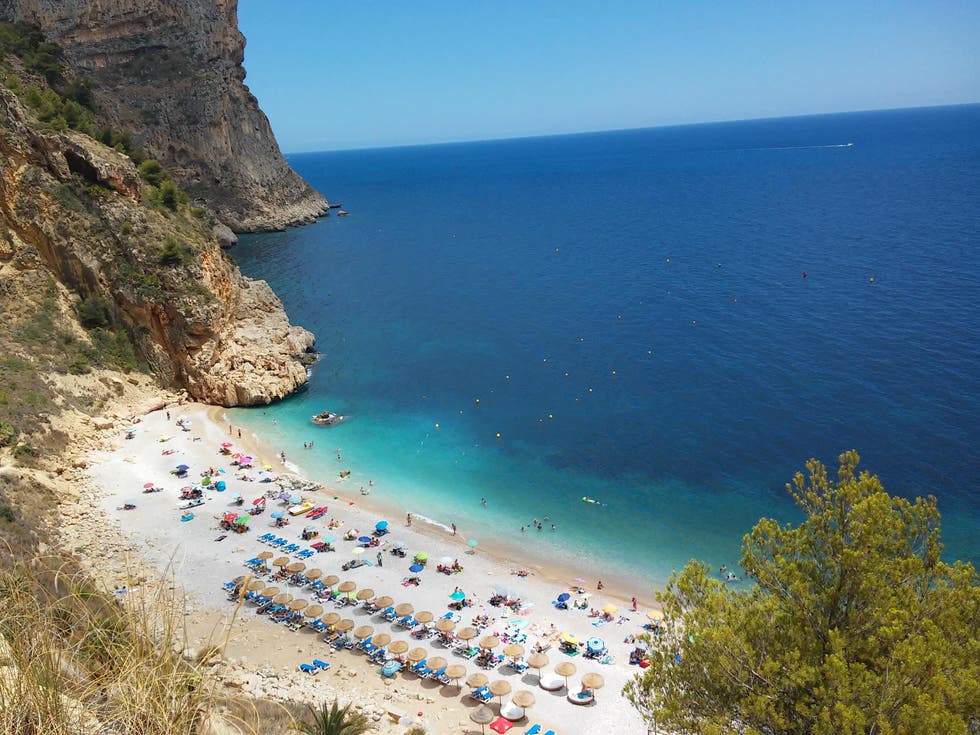Benitachell (Spanish: Benitachell, Valencian: El Poble Nou de Benitatxell) is a picturesque Spanish town surrounded by coves and rocks in the area (comarca) of Marina Alta, in the northeastern part of the province of Alicante, in the north of the Costa Blanca.
Brief information:
- Total area: 12,7 km²;
- Population: 4.276 (total), 2.552 (foreigners);
- Coastline: about 2 km;
- The nearest international airports: Alicante-Elche Airport (IATA: ALC, ICAO: LEAL) – 92 km, Valencia Airport (IATA: VLC, ICAO: LEVC) – 130 km;
- The nearby resort towns: Javea – 7,5 km, Calpe – 16 km, Denia – 19 km, Altea – 28 km;
- Municipality website: elpoblenoudebenitatxell.com
The History of the Town of Benitachell

Thanks to archaeological excavations near the Cave of the Moor (la Cueva del Moro), scientists were able to establish that the lands on this shore were inhabited up till 18 thousand years ago. The retrieved artefacts indicate that on the site of the present-day Benitachell, dating back to the Bronze Age, there were also settlements of Iberians, Roman conquerors and Muslims who had invaded at the beginning of the VIII-th century, and from which, according to one version, the town got its name ‘Benitagell’, where the first part of the word ‘beni’ supposedly meant ‘son’, and the meaning of the second part of the word is still a mystery. The Muslims erected a small fortress in the town that simultaneously served as an observation tower and shelter for local people in case of attacks, which were not uncommon throughout the town’s history.
After the invasion of the Aragon and Castile troops led by Jaime I el Conquistador in 1244, the Arabs had to leave this area. Further Christianization was by no means peaceful, and Benitachell was repeatedly destroyed. Only by 1698, the town was restored and its residents began to return home. Since the settlement had to be rebuilt literally from scratch, it began to name ‘Poble Nou de Benitachell’, that meant ‘New Village of Benitachell’, but later, given the lack of ‘Old Benitachell’, the town was gone back calling simply ‘Benitachell’… However, the official name of the municipality in the Valencian dialect – Poble Nou de Benitachell – has survived.
Economy, gastronomy and tourism in Benitachell

The important industries in Benitachell are the agrarian and tourism sector. Citrus orchards bloom around the town, and the town can offer a good range of its own vegetables. Winemaking has flourished here since Roman times, and today there are growing local grape varieties including Moscatel or Muscat, from which homemade wines are produced, raisins, and a delicious local liqueur – la mistela. In addition to raisins, almonds are also often used in traditional desserts, and the most famous local sweets include Coca-María, Caspell con Pasas y Almendras, Pastissets and Easter treats Monas de Pascua.
As with most of Valencian municipalities, paella with seafood and meat is often prepared in establishments of Benitachell, as well as a variety of tasty fish specialities. Amongst the most popular dishes are: Cruet – a stone fish dish, Calamars farcits amb blanque – with squid, and Putxero de Polp – with octopus.
From the middle of the twentieth century in Benitachell, as well as throughout the Costa Blanca, the service sector began to develop rapidly. This was due to the increased interest of tourists in the region, particularly on the part of European citizens. Nowadays, residents of the European Union often come to Benitachell to spend their retirement years in this beautiful and cozy place, among the picturesque mountains and seascapes, in full peace and safety.
The popularity of the town has led to the fact that over the past twenty years the number of inhabitants of Benitachell has almost doubled: from 2312 (2000) to 4452 (2020) people. Moreover, more than half of the population are foreigners, as stated above, mainly of European origin.
Tourist attractions in Benitachell

Benitachell is not only a town of amazing natural beauty, but also of interesting historical sights.
The town center is located on a hill and retains the structure of a typical Mediterranean village: most of the buildings are reminiscent of Arab quarters with narrow its sloping streets on small hills. The walls of the first houses of Benitachell were connected to the walls of the church, forming a single fortified building with two entrances, one of which has survived to this day.
The Church of St. Mary Magdalene (La Iglesia de Santa María Magdalena)
This is a magnificent building of the XVIII-th century and the main attraction of the town. Outside this building, there is in the neo-baroque style with classical features, and the beautiful dome of the church is covered with white and blue tiles and can be seen from virtually anywhere in the town.
The interior of the Church of St. Mary Magdalene looks modest, but refined and elegant. In the very center stands an altar with the figure of the patron saint.
The Oratory of St. James the Apostle (El Oratorio de San Jaime Apóstol)

This is the next architectural landmark of Benitachel. An ancient structure consistists of a small chapel, a courtyard and former classrooms. This building dates back to the end of the XIX century.
Before heading to see the natural sights, one should pay attention to some man-made facilities. For example, there are so-called caves (cuevas). These are small stone structures attached to the walls of rocks.
It is also worth visiting artificial fishermen – pesqueras. These are structures that are a set of ropes and ladders, along which real fishermen went down the rocks to fish at night in the old days. Now, boat tours along the coast of Benitachell are organized to see these unusual structures in all their glory.
Coast line and beaches of Benitachell

The coastline of Benitachell is extremely scenic with its beaches and coves, and its landscape is rich in unique features:
- Cala del Moraig is a bay with a length of about 250 m and an average width of 40 m. It has convenient access by road, tourist services are offered.
- Cala de Llebeig is a bay with a length of about 100 m and an average width of 10 m. Unlike the first bay, one can’t drive up close here, but it is possible to get there on foot.
- Cala dels Testos is a bay with a length of about 150 m and an average width of 100 m. There is no road by car to the bay, but there is a good walking route.
- Cova dels Arcs (Cova dels Arcs) is a cave located on the southern side of the Moraig Bay, and arose due to the drainage of karst layers. As a result, the cave turned from coastal to underwater, and its walls formed impressive coastal arches under the influence of the surf.
- Falla del Moraig – this rift runs parallel to the Moraig Bay, crosses the cave dels Arx and reaches the sea. If one goes down the road leading to the bay of Cala de Moraig, then there will be a path on the right, by walking along, one can observe the surface of the rift Falla del Moraig.
- The underground river Moraig or Rio Blanc (Moraigo Riu Blanc). This is a river in the depths of the caves, carrying its waters into the bed of the Benissa River, has a wide main channel, which then branches off. Studies conducted by underwater speleologists indicate 2 km of channels that reach a depth of 60 m below sea level.
- The Basenilla rift (La Basenilla) – it has a rounded shape with vertical walls and retains numerous fallen stone blocks of impressive size inside.
Amazing routes of different levels of complexity have been developed along caves, bays, grottos and rifts, here are the names of the most popular:
- Route along the rocks (La Ruta de los Acantilados).
- Route along the fault (La Ruta De La Falla).
- Route along the ravine (La Ruta del Barranco dels Testos)
- Underwater route (La Ruta Submarine).
Those who are fond of diving should definitely explore the mysterious underwater cave of Los Arcos (La Cueva Submarina de los Arcos).
Public holidays in Benitachell

Fervent Spain cannot be imagined without its numerous fiestas. Of course, Benitachell is not an exception in this. The town’s public
holiday calendar looks like this:
- The Holy Week (La Semana Santa). There are bright Easter processions, taking place in late March – early April.
- The Rose Festival (La Fiesta de La Rosa). The fiesta starts on the first weekend of May and lasts for a whole week.
- The Moors and Christians (Los Moros y Cristianos). The carnival procession is held on the second weekend of July, on St. Sebastian’s Day.
- The Patron Saint’s Day Festivities (Las Fiestas Patronales). There are celebrations of the patron saints of the town. The festivities last from July 22. to 31.
- The Christmas Fair (El Mercado de Navidad). On this holiday, beloved by adults and children, locals are having a big bazaar in the town, which is held on the Sunday before Christmas (El Domingo antes de Navidad). This is where one can get everything:
Christmas and other festive souvenirs, traditional Spanish sweets, and lovely gifts for family and friends.
Real estate in Benitachell
According to the portal idealista.com for August 2021, the average cost of housing in Benitachell was 2260 €/m2. At the same time, despite the difficult situation in the world due to the coronavirus pandemic, real estate prices here not only do not decrease, but also show a slight spike: +0.8% – for a month, and +3.5% – for a year.
The cost of apartments in Benitachell is on average: about 75.000 € – one bedroom, 80.000 € –two bedrooms, 96.000 € – three bedrooms.
A cozy three room-bungalow with mountain views will cost from 115.000 €, a villa with a garden and a comunidad pool – from 149.000 €, a chalet with a magnificent sea views – from 152.461 €.
For more housing options, please find our catalog or contact our real estate agents.



